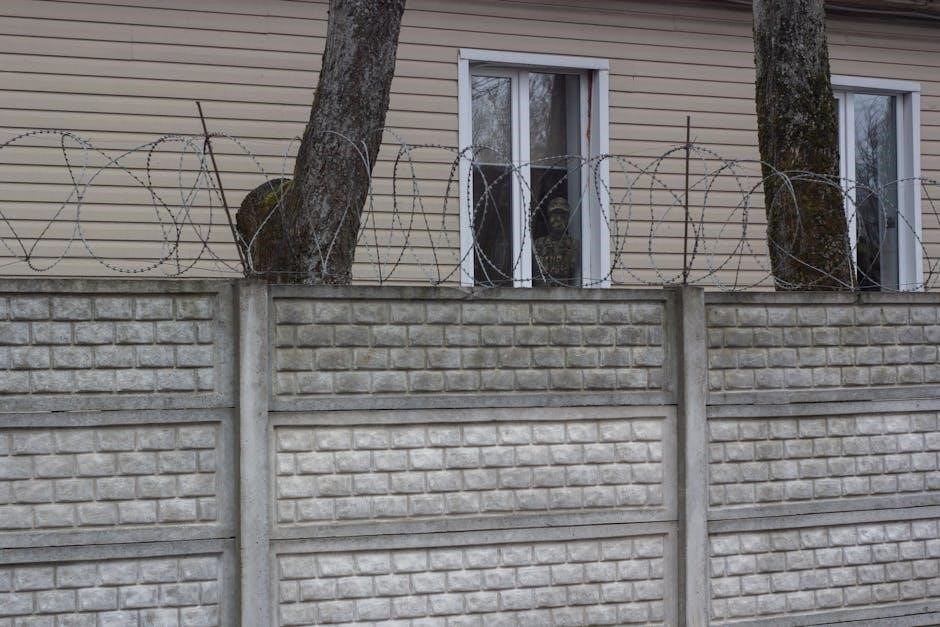Perimeter and area worksheets are essential tools for mastering geometry concepts, offering a variety of problems for different grade levels and learning styles, with step-by-step solutions.
What Are Perimeter and Area?
The perimeter of a shape is the total distance around its edges, while the area is the space inside it. Both concepts are fundamental in geometry and are used to solve real-world problems, such as calculating the amount of fencing needed for a garden or the paint required for a wall. Perimeter is measured in linear units (e.g., cm, m), and area is measured in square units (e.g., cm², m²). These measurements are essential for understanding spatial relationships and are applied in various fields, including architecture, engineering, and everyday activities. Worksheets on perimeter and area provide students with practical exercises to master these concepts, offering problems for different shapes and scenarios. They help learners apply formulas correctly and visualize geometric principles, making them indispensable for building a strong foundation in mathematics.
Importance of Worksheets in Learning
Worksheets are vital tools for practicing and reinforcing mathematical concepts, including perimeter and area. They provide structured exercises that help students apply formulas, visualize problems, and develop problem-solving skills. By offering a variety of problems, worksheets cater to different learning styles and grade levels, ensuring comprehensive understanding. Regular use of worksheets builds confidence, improves accuracy, and enhances mathematical fluency. They also allow for self-assessment, as many include answer keys, enabling students to identify and correct mistakes. Worksheets are particularly effective for hands-on learning, making abstract concepts like perimeter and area more tangible. Their availability in PDF formats makes them easily accessible and printable, offering flexibility for both classroom and home use. This structured practice is essential for mastering geometry fundamentals and preparing for advanced math challenges.
Benefits of Using Perimeter and Area Worksheets
Perimeter and area worksheets enhance problem-solving skills, improve geometry understanding, and reinforce mathematical fundamentals, providing structured practice for students to master these essential concepts effectively.
Improved Understanding of Geometry Concepts

Perimeter and area worksheets help students develop a clear understanding of geometry by providing structured practice in calculating dimensions for various shapes. These exercises, available in PDF formats for grades 3-8, focus on rectangles, trapezoids, triangles, and composite figures, ensuring a comprehensive grasp of formulas and their applications. By solving problems involving different shapes, students learn to visualize and apply geometric principles effectively. The inclusion of word problems further enhances their ability to relate mathematical concepts to real-world scenarios. Regular practice with these worksheets builds confidence and fluency, enabling students to approach more complex geometry challenges with ease. Additionally, the availability of answer keys allows for self-assessment, reinforcing learning and identifying areas for improvement. This systematic approach ensures a strong foundation in geometry, making these worksheets an invaluable resource for students.
Enhanced Problem-Solving Skills

Perimeter and area worksheets are designed to enhance problem-solving skills by presenting students with a variety of challenges, from basic calculations to complex word problems. These exercises, often available in PDF formats, encourage students to apply geometric formulas to real-world scenarios, fostering critical thinking and analytical abilities. For instance, worksheets on trapezoids and composite shapes require students to break down problems into manageable parts, promoting a systematic approach to problem-solving. Additionally, the inclusion of word problems helps students connect mathematical concepts to practical situations, such as calculating the perimeter of a garden or the area of a room. By regularly practicing these problems, students develop resilience and confidence in tackling mathematical challenges, making these worksheets an excellent tool for improving overall problem-solving skills.

Reinforcement of Mathematical Fundamentals
Perimeter and area worksheets play a crucial role in reinforcing mathematical fundamentals by providing structured practice for students to master essential concepts. These worksheets, often available in PDF formats, focus on basic formulas and unit conversions, ensuring a strong foundation in geometry. By repeatedly solving problems, students internalize the difference between perimeter (measuring distance around a shape) and area (measuring space inside a shape). Worksheets also emphasize accurate calculations, helping students avoid common errors like misapplying formulas or mismanaging units. Additionally, the inclusion of step-by-step solutions and answer keys allows students to review their work, identify mistakes, and improve their understanding. Regular practice with these resources builds confidence and fluency, making complex mathematical tasks more approachable. This consistent reinforcement ensures that students develop a solid grasp of these fundamental skills, which are vital for advanced math studies.
How to Find Perimeter and Area Worksheets Online
Search popular websites like mathworksheets4kids.com or CommonCoreSheets for free PDFs. Use keywords like “grade-specific perimeter and area worksheets” to find resources tailored to your needs.
Popular Websites for Math Worksheets
Several websites offer high-quality perimeter and area worksheets in PDF format. MathWorksheets4Kids provides a wide range of free printable worksheets for various grades, including problems on rectangles, trapezoids, and multi-shape figures. CommonCoreSheets is another excellent resource, offering free area and perimeter worksheets tailored to different learning levels. Additionally, websites like White Rose Maths and Spectrum Math include detailed problem sets and answer keys. These platforms cater to different grade levels, from basic concepts for younger students to advanced challenges for higher grades. Many of these worksheets are designed to be interactive, with features like word problems and step-by-step solutions. They are ideal for both classroom use and home study, ensuring comprehensive practice for students mastering geometry concepts.
Tips for Selecting the Right Worksheets
When choosing perimeter and area worksheets, consider the student’s grade level and skill set to ensure the content is appropriate. Look for worksheets that align with curriculum standards and include a mix of problem types, such as basic calculations, word problems, and shape variations. Opt for resources that offer visual aids, like diagrams, to support visual learners. Worksheets with step-by-step solutions and answer keys are ideal for self-study and quick feedback. Additionally, select worksheets that cater to different learning styles, such as hands-on activities for kinesthetic learners. Ensure the problems progress in difficulty to build confidence and mastery. Finally, choose worksheets from reputable sources, like MathWorksheets4Kids or CommonCoreSheets, to guarantee quality and accuracy. These tips help educators and parents provide effective practice materials for geometry concepts.

Grade-Specific Perimeter and Area Worksheets
Grade-specific worksheets provide targeted practice, from basic concepts for younger students to advanced challenges for older learners, ensuring appropriate difficulty and skill progression in geometry.
Worksheets for Grade 3-4: Basic Concepts

Worksheets for Grades 3-4 focus on introducing fundamental concepts of perimeter and area. These resources typically include simple shapes like rectangles and squares, with clear instructions and visual aids to help young learners grasp basic formulas. Activities often involve calculating the perimeter by adding side lengths and determining area by counting squares or using multiplication. Word problems are also introduced to connect mathematical concepts to real-life scenarios, making learning engaging and relatable. Many worksheets at this level incorporate colorful diagrams and illustrations to cater to visual learners, ensuring a solid foundation for more complex geometry topics in higher grades. Additionally, step-by-step solutions and answer keys are provided to assist both students and educators in assessing progress and understanding.

Worksheets for Grade 5-6: Intermediate Problems
Worksheets for Grades 5-6 introduce more complex problems, building on foundational knowledge of perimeter and area. These resources often include calculations for various shapes, such as trapezoids, triangles, and irregular polygons, requiring students to apply formulas accurately. Word problems are emphasized, encouraging students to interpret real-world scenarios and translate them into mathematical solutions. Mixed-shape problems and multi-step calculations are common, helping to refine problem-solving skills. Additionally, these worksheets may incorporate activities like finding missing side lengths or comparing perimeters and areas of different shapes. Answer keys and step-by-step solutions are frequently provided to support learning and assessment. These intermediate worksheets are designed to prepare students for advanced geometry concepts in higher grades while reinforcing their understanding of spatial relationships and measurement skills.
Worksheets for Grade 7-8: Advanced Challenges
Worksheets for Grades 7-8 offer advanced problems designed to deepen students’ understanding of perimeter and area. These resources typically involve complex shapes, such as compound figures, irregular polygons, and mixed operations requiring the application of multiple formulas. Word problems are more intricate, often involving real-world scenarios like calculating fencing for a garden or flooring for a room. Students are challenged to find perimeters and areas of shapes with missing dimensions, using algebraic reasoning and spatial visualization. Mixed-unit problems and conversions between units are also common, enhancing mathematical fluency. These worksheets often include answer keys and step-by-step solutions to help students review and refine their problem-solving strategies. They are ideal for preparing students for high school-level geometry and fostering advanced critical thinking skills in mathematics.

Key Features of Effective Perimeter and Area Worksheets
Effective worksheets include a variety of shapes, word problems, and step-by-step solutions. They often feature answer keys, ensuring clarity and reinforcing mathematical concepts for better understanding and retention.
Variety of Shapes and Problems
Effective worksheets incorporate a wide range of shapes, such as rectangles, triangles, trapezoids, and composite figures, ensuring diverse problem-solving experiences. Problems vary in complexity, from basic calculations to real-world applications, enhancing adaptability. Word problems and unit conversion exercises are often included, promoting critical thinking and practical skills. This variety helps students grasp how perimeter and area apply to different geometric figures, reinforcing their understanding of spatial relationships and mathematical formulas. By engaging with multiple problem types, learners develop a stronger foundation in geometry and improved problem-solving abilities. The inclusion of diagrams and illustrations further supports visual learners, making concepts more accessible. Overall, diverse and challenging problems prepare students for advanced mathematical concepts and real-life scenarios, fostering confidence and proficiency in geometry.

Inclusion of Word Problems
Word problems are a crucial component of effective perimeter and area worksheets, as they bridge the gap between abstract concepts and real-world applications. These problems require students to apply their knowledge of formulas and calculations to practical scenarios, enhancing their critical thinking and problem-solving skills. For instance, worksheets often include questions like calculating the perimeter of a rectangular garden or determining the area of a room for flooring. Such problems help students understand the relevance of geometry in everyday life. Additionally, word problems often involve multi-step solutions, encouraging learners to break down tasks and approach them systematically. This feature is particularly beneficial for developing analytical skills and preparing students for more complex mathematical challenges in higher grades. By integrating word problems, worksheets ensure a comprehensive learning experience that goes beyond mere formula memorization.
Step-by-Step Solutions and Answer Keys
Step-by-step solutions and answer keys are invaluable features of perimeter and area worksheets, providing students with clear guidance and immediate feedback. These resources help learners understand how to approach problems methodically, breaking down complex calculations into manageable parts. For example, worksheets often include detailed explanations for finding the perimeter of irregular shapes or calculating the area of composite figures. Answer keys allow students to verify their results, identifying and correcting mistakes independently. This fosters a deeper understanding of concepts and builds confidence. Many worksheets, such as those for grades 5-8, include both worked examples and blank spaces for students to practice, making them a comprehensive tool for learning. The inclusion of step-by-step solutions ensures that students grasp not just the “how” but also the “why” behind each problem, reinforcing their mathematical foundation.
Using Worksheets for Different Learning Styles
Worksheets cater to visual learners with diagrams and illustrations, while kinesthetic learners benefit from hands-on activities, ensuring diverse learning needs are met effectively through interactive problems and exercises.
Visual Learners: Diagrams and Illustrations
Visual learners benefit greatly from worksheets that incorporate diagrams and illustrations, making complex concepts like perimeter and area more tangible. These visual aids help students connect formulas to real-world shapes, enhancing understanding. Many worksheets, such as those for grades 5-7, include detailed diagrams of rectangles, trapezoids, and other shapes, allowing learners to see how measurements translate into calculations. Illustrations also guide students through step-by-step problem-solving, making abstract ideas concrete. For instance, diagrams of composite shapes help visualize how to break them into simpler forms for easier calculation. Additionally, visual elements like grids and labeled dimensions assist in accurately applying formulas. This approach ensures that visual learners can grasp and retain geometric principles effectively, making worksheets an invaluable resource for their educational journey.
Kinesthetic Learners: Hands-On Activities
Kinesthetic learners thrive when they can engage physically with math concepts, making hands-on activities a vital part of their learning process. Worksheets that incorporate practical tasks, such as measuring line segments or calculating perimeter and area using real-world objects, are particularly effective. For example, students can use rulers to measure the sides of shapes drawn on grid paper, reinforcing their understanding of how perimeter and area are calculated. Some worksheets also include cut-out shapes or foldable diagrams, allowing learners to manipulate and visualize geometric figures. Additionally, activities like creating models or designing rooms with specific dimensions help kinesthetic learners apply their knowledge in tangible ways. These interactive approaches, often included in PDF worksheets, ensure that students stay engaged and develop a deeper connection to the material. Hands-on learning makes abstract concepts like perimeter and area more accessible and memorable for kinesthetic learners.

Common Mistakes and Solutions
Common mistakes include misunderstanding formulas and improper unit conversion. Solutions involve double-checking formulas, ensuring consistent units, and practicing with guided worksheets to build accuracy and confidence in calculations.
Misunderstanding Formulas
Misunderstanding formulas is a common issue when calculating perimeter and area. Many students confuse the formulas for different shapes, such as using the area formula for a rectangle instead of the perimeter formula. For example, mixing up the concepts of multiplying length and width for area versus adding all sides for perimeter. This confusion often leads to incorrect calculations, especially for complex shapes like trapezoids or parallelograms. Additionally, students may forget to square the unit of measurement for area or misapply the order of operations. To address this, it’s essential to provide clear, step-by-step guides and practice exercises in worksheets. Answer keys with detailed solutions can help students identify and correct their mistakes, ensuring a stronger grasp of the formulas and their proper applications. Regular practice with varied problems also builds confidence and reduces errors over time.
Improper Unit Conversion
Improper unit conversion is another common mistake students make when calculating perimeter and area. For instance, mixing centimeters and meters without converting can lead to incorrect results. Many students forget to convert units before applying formulas, causing errors in both perimeter and area calculations. This issue is particularly noticeable when switching between metric and imperial systems, such as confusing inches with centimeters. To avoid this, worksheets should include clear guidelines on unit conversion and provide practice problems that require switching between units. Additionally, emphasizing the importance of consistent units in formulas can help students develop good habits. Answer keys should highlight unit conversion steps to reinforce proper practices. By addressing this issue, students can improve the accuracy of their calculations and gain a stronger understanding of measurement principles. Regular practice with unit conversion drills can also reduce errors over time.
